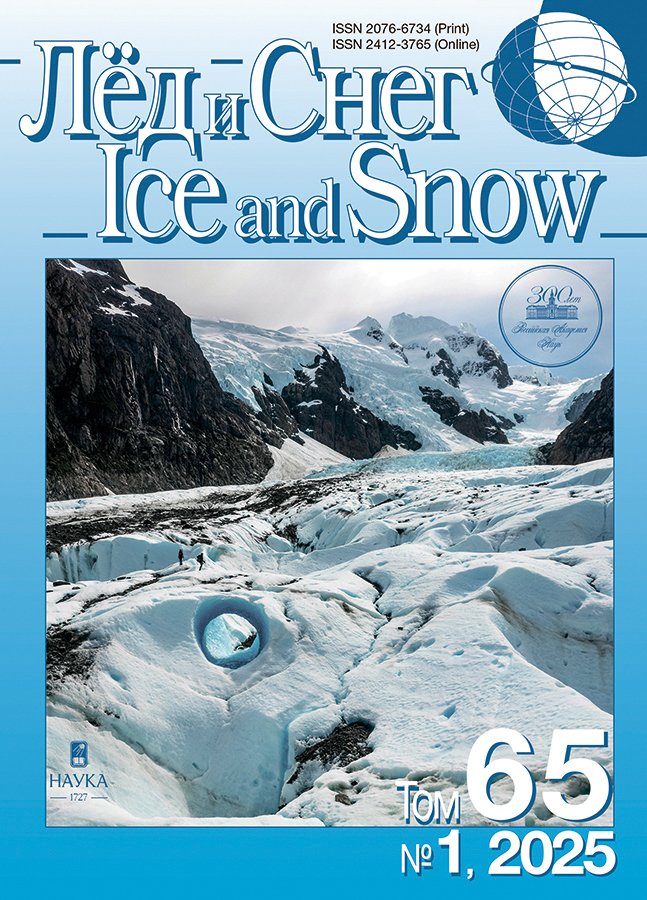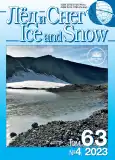The Snow Depth in Forests and Fields on Lowlands of Russia under the Current Climate Conditions
- Authors: Sosnovsky A.V.1, Osokin N.I.1
-
Affiliations:
- Institute of Geography, Russian Academy of Sciences
- Issue: Vol 63, No 4 (2023)
- Pages: 558-568
- Section: Snow cover and avalanches
- URL: https://journals.rcsi.science/2076-6734/article/view/162322
- DOI: https://doi.org/10.31857/S2076673423040166
- EDN: https://elibrary.ru/XMSKHE
- ID: 162322
Cite item
Full Text
Abstract
Received August 11, 2023; revised August 27, 2023; accepted October 2, 2023
Average values of maximum snow depths (MaxSD) estimated separately under conditions of forests and fields on lowlands of Russia were compared during the past 29 years. It was found that MaxSD in the fields for the current climatic period 1991–2020 increased by 5% compared to the period 1966–1990 and decreased by 8% in the forests. For the periods 1966–1990, 1981–2010, and 1991–2020, the ratio of MaxSD in a forest to similar one in a field (which we refer to as the snow survey coefficient) has been constantly decreasing. The snow survey coefficients for these periods were equal to 1.24; 1.12 and 1.08, respectively. In 1991–2020, the greatest values of this ratio were obtained in the northeast of the European part of the territory of Russia (ETR) and in the south of Western Siberia, where the maximum thickness of snow cover in the forest was found to be significantly higher than in the field. The lowest values were observed in some areas of the ETR center as well as in south-east and south-west, and in the south of Eastern Siberia. Here, for the periods 2001–2010 and 2011–2020, the values of the snow survey coefficients were estimated as 1.07 and 1.03 respectively. The coefficient for 1991–2020 decreased, on average, by 12% compared to 1966–1990. The maximum decrease in this ratio – by 15–25% – occurred in the south-west of Eastern Siberia and in a larger part of the ETR in the south. In 2011–2020, the MaxSD values increased in forests in the south-east of the ETR by 5–15%, and decreased in the south-west and the west of the ETR by 15–25% compared to 1966–1990. At the same time in fields, the MaxSD increased by 15–30% in the east of the ETR and the south of Siberia and decreased in the center and south-west of the ETR by 10–15%. The average value of the MaxSD in the field for the period 2011–2020 increased by 6% compared to 1966–1990 and decreased in the forest by 10%. Relative to other periods, the greatest increase in MaxSD was observed in 2001–2010. In the period 2011–2020, the MaxSD both in the forest and in the field mainly decreased relative to the period 2001–2010. In the current climatic period (1991–2020), the tendency for equalization of the MaxSD in forests and fields has been confirmed.
Keywords
About the authors
A. V. Sosnovsky
Institute of Geography, Russian Academy of Sciences
Author for correspondence.
Email: alexandr_sosnovskiy@mail.ru
Russia, Moscow
N. I. Osokin
Institute of Geography, Russian Academy of Sciences
Email: alexandr_sosnovskiy@mail.ru
Russia, Moscow
References
- Borzenkova A.V., Shmakin A.B. Changes in the snow cover thickness and of daily snowfall intensity affecting the highways cleaning expenses in Russian cities. Led I Sneg. Ice and Snow. 2012, 2 (52): 59–70 [In Russian]. https://doi.org/10.15356/2076-6734-2012-2-59-70
- Bulygina O.N., Razuvaev V.N., Korshunova N.N. Snow cover over the Russian territory and its spatial and temporal changes in 1966–2010. Problemy ekologicheskogo monitoringa i modelirovaniya ekosistem. Problems of ecological monitoring and modeling of ecosystems. 2011, 24: 211–227 [In Russian].
- Voeykov A.I. Snow cover, its influence on soil, climate and weather and methods of research. Zapiski imperatorskogo Russkogo geograficheskogo obshchestva po obshchej geografii. Notes of the Imperial Russian Geographical Society on General Geography. 1889, 18 (2): 213 [In Russian].
- Doklad ob osobennostyah klimata na territorii Rossijskoj Federacii za 2022 god. Report on the peculiarities of the climate in the territory of the Russian Federation for 2022. Moscow: Roshydromet, 2023: 104 p. [In Russian].
- Koronkevich N.I., Georgiadi A.G., Dolgov S.V., Barabanova E.A., Kashutina E.A., Milyukova I.P. Change in snow flood flow in the southern macro-slope of the Russian Plain in the period 1930-2014. Led i Sneg. Ice and Snow. 2018, 4 (58): 498–506 [In Russian]. https://doi.org/10.15356/2076-6734-2018-4-498-506
- Kotlyakov V.M. Cryosphere and climate. Ekologiya i zhizn’. Ecology and life. 2010, 11: 51–59 [In Russian].
- Mishon V.M. Theoretical and methodological foundations of resources of surface waters assessment in zones of insufficient and unstable humidification at European territory of Russia. Doctoral thesis in Geography. Voronezh: Voronezh State Pedagogical University, 2007: 65 p. [In Russian].
- Oleinikov A.D., Volodicheva N.A. Recent trends of snow avalanche regime in the Central Caucasus (Elbrus region as an example). Led i Sneg. Ice and Snow. 2019, 2 (59): 191–200 [In Russian]. https://doi.org/10.15356/2076-6734-2019-2-400
- Osokin N.I., Samoilov R.S., Sosnovsky A.V. Assessment of the effect of snow cover thickness on permafrost degradation during climate warming. Izvestiya RAN. Seriya Geograficheskaya. Proc. of the RAS. Geographical series. 2006, 4: 40–46.
- Osokin N.I., Samoilov R.S., Sosnovsky A.V., Sokratov S.A. On the role of some natural factors in soil freezing. Materialy Glyatsiologicheskikh Issledovaniy. Data of Glaciological Studies. 2000, 88: 41–45 [In Russian].
- Osokin N.I., Sosnovsky A.V. Influence of snow cover thermal resistance on permafrost stability. Kriosfera Zemli. Earth’s Cryosphere. 2016, XX (3): 105–112 [In Russian].
- Perevertin K.A., Belolyubcev A.I., Dronova E.A., Asau-lyak I.F., Kuznetsov I.A., Mazirov M.A., Vasiliev T.A. Impact of changes in snow cover regime on agronomic risks causing pink snow mold. Led I Sneg. Ice and Snow. 2022, 62 (1): 75–80 [In Russian]. https://doi.org/10.31857/S2076673422010117
- Popova V.V., Shiryaeva A.V., Morozova P.A. Changes in the snow depth characteristics in the territory of Russia in 1950–2013: the regional features and connection with the global warming. Kriosfera Zemli. Earth’s Cryosphere. 2018, XXII (4): 65–75 [In Russian].
- Sosnovskiy A.V., Osokin N.I., Chernyakov G.A. Impact of climate change on snow depth In forest and field areas in the first decade of the xxi century. Kriosfera Zemli. Earth’s Cryosphere. 2018, XXII (2): 91–100 [In Russian]. https://doi.org/10.21782/KZ1560-7496-2018-2(91-100)
- Sosnovsky A.V., Osokin N.I., Chernyakov G.A. Dynamics of snow storages in forests and fields of Russian plains under climate changes. Led I Sneg. Ice and Snow. 2018a, 58 (2): 183–190 [In Russian]. https://doi.org/10.15356/2076-6734-2018-2-183-190
- Sukhova O.V., Vaisfeld M.A. Modeling the redistribution of snow cover in the Russian Far East which is the key parameter of the winter biotopes of hooves. Led I Sneg. Ice and Snow. 2021, 61 (1): 89–102 [In Russian]. https://doi.org/10.31857/S2076673421010073
- Formozov A.N. Snezhnyi pokrov kak faktor sredy, ego znachenie v zhizni mlekopitayushchikh i ptits SSSR. Snow cover as an environmental factor, its significance in the mammals and birds life of the USSR. Moscow: Moscow State University, 1990: 287 p. [In Russian].
- Irannezhad M., Ronkanen A.-K., Malekian A. Editorial: Climate impacts on snowpack dynamics. Front. Earth Sci. 2022: 10 p. https://doi.org/10.3389/feart.2022.970981
- Snow and Climate: Physical Processes, Surface Energy Exchange and Modeling / Armstrong R.L., Brun E. (Eds.). Cambridge University Press, 2008: 256 p.
Supplementary files















